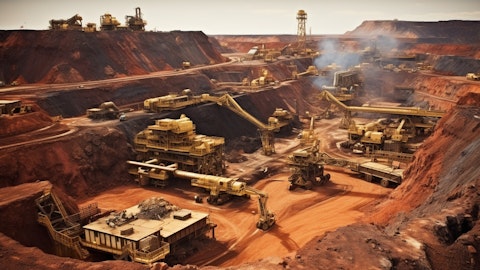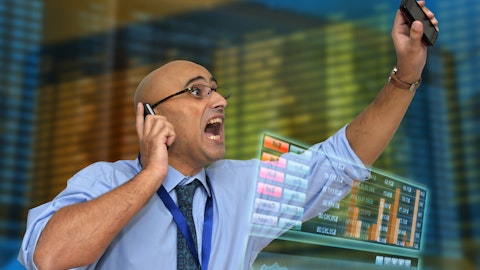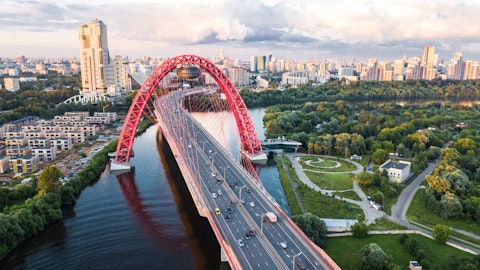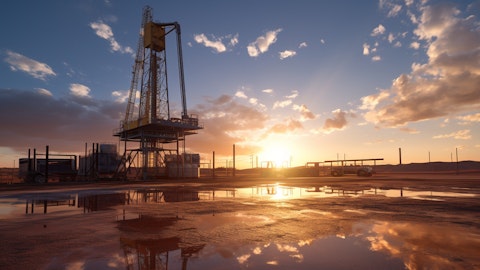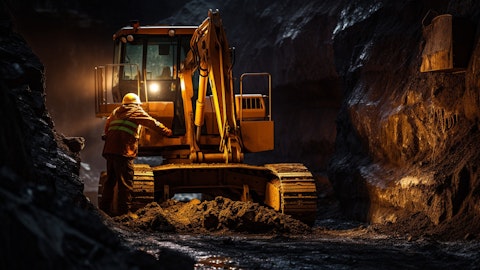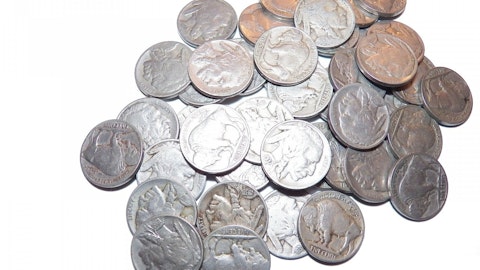Vale S.A. (NYSE:VALE) Q4 2023 Earnings Call Transcript February 23, 2024
Vale S.A. isn’t one of the 30 most popular stocks among hedge funds at the end of the third quarter (see the details here).
Operator: Good morning ladies and gentlemen. Welcome to Vale’s Fourth Quarter 2023 Earnings Call. This conference is being recorded and the replay will be available at the company’s website, vale.com. The presentation is available for download in English and Portuguese. This call is also available in Portuguese. To listen to the presentation in Portuguese, please press the globe icon on the lower right side of your Zoom screen and then choose to enter the Portuguese room. Then select mute original audio, so that you won’t hear the English version in the background. We would like to inform that all participants are currently in a listen-only mode for the presentations. Further instructions will be provided before we begin the question-and-answer section of our call.
We would like to advise that forward-looking statements may be provided in this presentation, including Vale’s expectations about future events or results encompassing those matters listed in the respective presentation. We caution you that forward-looking statements are not guarantees of future performance and involve risks and uncertainties. To obtain information on factors that may lead to results different from those forecast by Vale, please consult the reports Vale files with the U.S. Securities and Exchange Commission, the Brazilian Comissão de Valores Mobiliários, and in particular the factors discussed on the forward-looking statements and risks factors in Vale’s annual report on Form 20-F. With us today are Mr. Eduardo De Salles Bartolomeo, CEO; Mr. Gustavo Pimenta, Executive Vice President of Finance and Investor Relations; Mr. Marcello Spinelli, Executive Vice President, Iron Ore Solutions; Mr. Carlos Medeiros, Executive Vice President of Operations; and Mr. Mark Cutifani, Chairman of Vale Base Metals.
Now I’ll turn the conference over to Mr. Eduardo Bartolomeo. Sir, you may now begin.
Eduardo De Salles Bartolomeo: Thank you and good morning everyone. I hope you are all doing well. 2023 was a remarkable year for Vale. Our results translated the evolution of our safe-driven cultural transformation and our progress towards operational excellence. We have walked the talk and delivered in line with our guidances. I’m excited that we are now taking Vale to an even higher level of performance to the five key levers we outlined on the last Vale Day. Starting with our safety journey, which in 2023 showed encouraging improvements with the lowest injury frequency rate since 2008 and relevant accomplishments in dam management. Our second lever, the stabilization of our iron ore operations comes to secure our baseline production of 310 million to 320 million tons per year.
In that sense, our 2023 production at 321 million tons exceeded expectations and provided evidence of increased asset and process reliability. On our third lever, growing volumes in iron ore with quality, we gave an important step by starting up our first briquette plant. In addition, our partnership with Anglo America in a world-class operation will bring synergies and make available high-quality feeds for agglomerated products. Gustavo will share more information on that later. In our path to transform the Energy Transition Metals business, copper production had an impressive 50% growth in the fourth quarter. Nickel production was in line with guidance with results benefited by price realization 7% above LME prices in the quarter. In our quest towards ESG leadership in mining, 2023 saw a substantial progress in the reparations of Brumadinho and Mariana.
Finally, by announcing a $2.4 billion dividend distribution, we reinforced that our discipline in capital allocation and commitment to shareholder return remains unchanged. Let’s see more details of our 2023 performance now. Please next slide. As you know, safety is the most important work front for me at Vale. We are committed to ensuring that each employee is safe during work shifts. We achieved solidly safe performance in the year with the lowest injury frequency rate in the company history and one of the lowest in our industry. The year was also remarkable for our dam management performance. We reached performance with the global industry standard for tailing management within the expected industry timeframe. Our upstream dam decharacterization program reached 43% completion rate.
B3 before, an upstream dam, which was at emergency level 3 back in 2019, had over 90% of its tailings removed, bringing forward the dam elimination in three years, from 2027 to 2024. We are already seeing a safer Vale, built with operational discipline in maturing management model. Next slide please. The fourth quarter was a very strong one, leading us to deliver an iron ore output that exceeded our guidance. Year-on-year, we increased our output in 11% and in December we had the highest monthly output since 2018. We are ensuring our asset reliability. Our meantime between failure, for example, improved considerably, almost doubling the performance in the S11D truckless systems case. In pellets, our strong output was supported by the start-up of the Torto dam in 2023 and therefore the higher pellet feed production at Brucutu.
In 2024, we are at a fast pace to deliver another strong performance. Next slide please. Vale’s major competitive advantage is its potential to grow its high quality portfolio with low capital intensity. In that sense, we are targeting the development of three key projects combined with the development of Mega Hubs, concentration facilities at briquette plants. Our three key projects are being executed. The Vargem Grande Complex expansion, the Capanema project and the S11D plus 20 expansion. With those addings to our current production baseline, we expect to reach 340 million to 360 million tons productions by 2026. Next slide please. In 2023, we continue to mature our agreements for joint assessments on the construction of mega hubs with authorities in the United Arab Emirates, Saudi Arabia, and Oman and with partners in Brazil.
We are also assessing the feasibility of developing green steel hubs in Brazil and North America with H2 Green Steel, a Swedish partner. Finally, we are ramping up the first briquette plant in our Tubarão complex with the second plant expected to ramp up in the first half of 2024. With growing volumes, higher average iron content and cost efficient program in place, we are preparing Vale to be one of the most efficient mining companies in the world. Next slide please. In the Energy Transition Metals business, we delivered a remarkable output in copper, an outstanding 50% increase quarter-on-quarter driven by the successful ramp up of Salobo III and improved performance at Salobo I and II plants. In nickel, our production was in line with guidance which already factored the transition of Voisey’s Bay mine extension.
In 2023, we successfully established Vale Base Metals, a new company with separate governance overseeing Vale’s Energy Transition Metals business. Delivering on our commitments, we brought in important partners to the business as a mean to accelerate VBM’s growth, while ensuring greater operational efficiency in the short term. The upcoming years will be crucial for transitioning the Energy Transition Metals to a new phase. The asset review is underway and we will provide more color on that process along 2024. Next slide please. We are consistently delivering and positioning Vale as an ESG leader. We are increasingly focusing on people with solid results so far and with encouraging improvements to come. We are a more diverse, equitable and inclusive company since we set our long-term goals back in 2019.
For instance, our female workforce increased by 85% in this period. On the social front, we continue to foster resilient communities. We are striving to be a nature-positive company uniquely positioned to leverage decarbonization efforts. Improving our transparency on our ESG performance we also became early adopters of the Task Force on Nature-related Financial Disclosures, the TNFD. Most importantly, we are delivering on our reparation processes. In Brumadinho 68% of the full reparation settlement were fulfilled, R$6.3 billion cash outflow in 2023. We expect to end 2026 with 90% of the obligations completed. In Mariana, the reparation has been accelerated by the Renova Foundation, with over 460,000 people compensated and over 85% of housing solutions provided, a total disbursement of R$34.7 billion since 2015.
On that front, we continue to negotiate a definitive reparation settlement with the Brazilian authorities. Our approach towards ESG has started to be acknowledged by ESG ratings providers and we are confident that our progress will be fully recognized in the near future. We are on our way to lead a sustainable mining, an industry able to create and share value with all of its stakeholders. Since 2019, we have made profound changes in Vale’s way of operating and are now reaping the benefits of that work. The executive team continues to be highly focused on our strategy and commitments. We are delivering on our safety and ESG commitments, always listening to our stakeholders. We are delivering more robust operational and cost performance across all businesses.
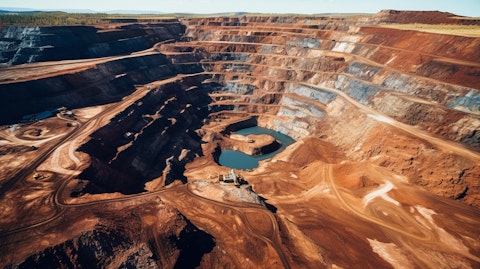
We are advancing our iron ore strategy towards growth with quality. We are positioning Vale for leadership in global de-carbonization, while driving local and regional development. Finally, we remain fully committed to disciplined capital allocation. To conclude, I would like to thank the management team, our employees, our partners, for contributing to the 2023 results. Now for our financial results, I pass the floor to Gustavo. Thank you.
Gustavo Pimenta: Thanks, Eduardo. And good morning everyone. Before going to our financial performance, I would like to spend some time talking about the strategic rationale and the associated financial aspects of our recently announced partnership with Anglo American in Brazil. As you probably saw in both companies’ releases, we have agreed to buy 15% of Minas-Rio existing business in exchange for a cash payment of $157 million, subject to net debt and working capital adjustments and the contribution of our world-class iron ore deposit of Serra da Serpentina in Minas Gerais. This combination is highly accretive for both companies as it allows us to leverage and maximize each other’s infrastructure, while securing access to additional high quality iron ore to support growing demand for low carbon and steel making.
Minas-Rio today has a nameplate capacity to produce up to 26.5 million tons per year of high quality pellet feed and the development of Serpentina will enable the total complex to reach over 50 million tons per year in the next decade. As per the agreed terms, Vale will have an option to buy another 15% stake of Minas-Rio at market terms once the Serpentina deposit obtains its preliminary license. This should allows us to have access to up to 15 million tonnes per year of pellet feed once Serpentina is fully developed. Vale have proportional off-take rights and we plan on using these volumes to feed our pellet facilities and later our briquetting plants, including the ones under the Mega Hub initiatives. Finally, we have also agreed on certain earn-out rights on both sides over the next four years with predefined caps as detailed in our market communication.
We are very excited to initiate this partnership with Anglo American in Brazil and expect this will unlock significant value to all of our stakeholders. As we mentioned, the supply of high quality iron ore is a key component of our strategy as we look to help our clients transition to a lower carbon footprint. Now let me turn back to our financial performance starting on the next slide. As you can see, our pro forma EBITDA was $6.7 billion in Q4, $2.7 billion higher year-on-year. The increase is explained by a combination of higher realized iron ore prices, which increased 24% versus a year ago, as well as by lower operating expenses, as we start to harvest the benefits of our efficiency and productivity programs. On prices the iron ore fines realized price was $128 per tonne in Q4 $23 per tonne higher year-on-year, driven by higher reference prices and the positive effect of provisional prices.
Given market conditions in Q4 with lower discount for high silica iron ore, we decided to increase this product’s share in the sales mix, while rebalancing premium iron ore inventories, especially Carajás. This proactive strategy not only maximizes our product portfolio value but also position us to better monetize our production going forward. Looking into the first quarter, market conditions remain favorable for high silica products and therefore, we should continue to manage our product portfolio accordingly. In order to provide greater clarity about our product portfolio mix, we have started to disclose the breakdown of each specific product in our quarterly report, which should facilitate the calculation in your understanding of our realized premiums and prices.
Regarding costs, our iron ore EBITDA breakeven declined 4% in Q4, reaching $53.3 per tonne in the quarter and $54.8 per tonne in 2023 below our most recent guidance. Our C1 cost performance in Q4 was solid as we move it closer to the $20 per tonne level supported by our efficiency program initiatives, a positive exchange rate impact and an inventory carryover effect. In 2023, C1 costs averaged $22.3 per tonne within our guidance range. As we presented at Vale Day, we expect costs in 2024 to be in line with 2023 with a C1 guidance of $21.5 to $23 per tonne. Moving to our energy transition metals business, our nickel all-in costs sharply declined in Q4, driven by the mine maintenance conclusion in Q3 and by 7% higher production volumes in the quarter, which also supported byproduct revenues.
In our corporate operations, higher byproduct volumes and prices led to a $300 per tonne increase in byproduct revenues. This was partially offset by higher maintenance costs at Sossego, despite higher production volumes in both operations. In C1 base metals, I’d like to share that we are making significant progress on our asset review under the leadership of Mark and have identified a series of opportunities to improve productivity and reduce unit operating costs. The plan has been primarily focused on asset integrity and mine development along with the flow sheet optimization. These opportunities are being assessed and designed for implementation over the next two to three years, with some benefits already being captured in the shorter term.
We plan on presenting the key action items of the asset review with the associated benefits by midyear. Now moving on to cash generation as you can see, Q4 free cash flow from operations was about $2.5 billion, roughly $1.4 billion higher than Q3, driven by higher EBITDA. Working capital increased in the quarter, driven by higher accounts receivable due to higher iron ore prices and sales. These invoices will be collected in Q1 this year, and we expect the effect on working capital to reverse in the following quarters. In addition, CapEx seasonally increased in Q4 as planned in our investment plan. With our full year CapEx at $5.9 billion, is slightly below our guidance. Most of the free cash flow was used to anticipate a $2 billion extraordinary dividend and interest on capital payment in December.
Also yesterday, our Board of Directors approved a distribution of $2.4 billion of dividends to be paid in March 2024, reinforcing our continued focus on returning value to shareholders. Now let me turn to our expanded net debt evolution in the next slide. We ended 2023 with an expanded net debt of $16.2 billion, compared to $15.5 billion in Q3. As you can see, this quarter we recognize an extra provision of $1.2 billion related to Samarco’s obligation and a potential global agreement with Brazilian authorities. The new provision, although still subject to uncertainty is our best estimate today of the amount required from Vale to fulfill those obligations, and it considers Samarco will continue to have the ability to pay for a portion of the required payments as per their approved business plan.
Since 2015, more than R$35 billion have been disbursed in 42 agreed programs, with almost 500,000 people compensated. We continue to be highly focused on a settlement that works for all parties involved within a framework that provides legal certainty and leads to an effective execution of their greed compensation. Regarding our optimal leverage target, we are maintaining the $10 billion to $20 billion range under the same expended net debt concept. This range provide us with greater flexibility and optimized capital costs. In the next quarters, we expected our expended net debt to benefit from our solid operational performance, enabling health value generation to our shareholders. So before moving on to the Q&A session, I would like to reinforce the key messages from today’s call.
We continue to make substantial progress in our safety and ESG commitments, as example by record low injury rates in our operations and continued advancements on upstream dam decharacterization. In iron ore, we are very encouraged with the recent operational performance from our assets and very confident on our ability to deliver on the targets for the year. On growth, we are seeing a very steady progress on our key projects to add 50 million tonnes per year of high quality iron ore with limited capital intensity by 2026. And I encouraged with the findings and initial implementation of the asset review in base metals. And finally, we remain highly committed to a disciplined capital allocation process as evidenced by today’s dividend announcement and the continuous execution of our highly accretive buyback program.
With that, I would like to open the call for questions. Thank you.
See also 20 Best Cities to Retire for 2024 and 13 Best Buy-the-Dip Stocks To Buy Right Now.
Q&A Session
Follow Vale S A (NYSE:VALE)
Follow Vale S A (NYSE:VALE)
Operator: We are going to start the question-and-answer section of the call. [Operator Instructions] Our first question comes from Leonardo Correa with BTG Pactual. You can activate your microphone.
Leonardo Correa: Hello, good morning, everyone. Can you hear me?
Eduardo De Salles Bartolomeo: Yes.
Leonardo Correa: Perfect. Yes. So I have a couple of quick…
Gustavo Pimenta: Leo, we lost you. This is Gustavo. We can’t hear you. I don’t know if you’re on mute.
Leonardo Correa: …rose a bit to about $16 billion, right, considering the…
Eduardo De Salles Bartolomeo: Leo, we lost you in a while, I think you have to restart your question, please.
Leonardo Correa: Okay. Sure. Sorry about that. Yes. So starting out with the dividend question, I mean in the quarter you paid the minimum dividend, right, as per the company’s policy. There were some doubts maybe a couple of months ago, but considering everything that’s happening and all the headlines from Samarco and the higher provision potential, it seemed to be the prudent approach, right, from you guys. The question is, considering that an additional provision has already been announced and that perhaps there could be a bit more visibility into these issues going forward. How do you think about extraordinary dividends in the second semester of the year? That would be my first question. Putting that together with the fact that I mean you still have some balance sheet room to increase your expanded net debt levels to $20 billion.
The second question, sorry to continue on this topic of these issues, right? But we’ve all been hearing about the headlines and somewhat concerned about the headlines, specifically on Samarco and Renova. I just wanted to hear you on how – I mean how you guys are progressing at this point with negotiations. Is there any idea on how, I mean or timing of these talks can evolve forward? That would be fantastic. I mean, do you expect this to be something for the first semester, or can this be perhaps something rolled out to the second semester?
Gustavo Pimenta: So, Leo, this is Gustavo. Thanks for your question. I hope you can hear me well. So look, on dividends, I think we will continue to see how the year evolves, right? And I think we are optimistic in terms of the operational performance of the business. We still have the cash from the minority sale of base metals to be received. We are certainly looking into that vis-à-vis some of the outstanding items that we talked about and within the $10 billion to $20 billion expended net debt concept that we’ve been working with. So it’s early to say. I would say we continue to be very focused on remunerating our shareholders at the best we can. And you should continue to expect this to follow that path. On the Samarco renegotiation and the settlement, look, we are working hard to reach a resolution.
There has been some progress lately on with all the parties. We continue to expect that a settlement will be reached and we are hopeful that a resolution can be again reached in the first half of this year. So we are working hard. It’s our interest, it’s the interest of our partners, and we see the interest from all the stakeholders to be able to reach a resolution there. And that’s what we are working towards.
Operator: Next question from Rodolfo Angele with JPMorgan. You can activate your microphone.
Rodolfo Angele: Hi, good morning, everyone. So I have two questions. The first one I wanted to ask to Carlos Medeiros, if possible. My question is the following, I think investors have been expecting not a lot from Vale at the end of the day, given all the challenges that the company faced on the operating side. But it seems like what we saw in the fourth quarter this year kind of starts to, at least here, we are happy to see that the company is kind of fighting a little bit the traditional seasonality that we see, especially in the fourth – hopefully in the first quarter of the year. So my question to you would be, can you talk a little bit about initiatives? What’s being done? Is this number that we saw already in the fourth quarter, already kind of showing the results of efforts that were taking by your team at Vale?
So that’s question number one. And my second question would be to Spinelli. I wanted to hear from you about – we discuss a lot about what’s going on in terms of Sudirman in China, and we leave the ex-China piece of the equation, which is quite relevant a little bit on the sidelines. So if you could comment on what you’re seeing, that would be very helpful. Thank you very much.
Carlos Medeiros: Rodolfo, thank you for your question. First, our performance on Q4 was solid. And this is due to all the efforts in reliability that we’ve been working on in all systems and also in our seasonality plan. This comprises several initiatives, but maybe I would highlight in our mines a careful management or control of our water level in order to keep the bottom of our pits in good working conditions for as long as possible. And also making sure that we have free ore available at the top of the pits to use whenever needed. Also some important actions in terms of mine infrastructure to make sure that they are well maintained in the port. We have a dry corrective material in our stocks there to blend with more humid ore and also improve drainage conditions at the port.
So all this together led us to stronger results in Q4 and also are sustaining our performance during Q1. Although, this is El Nino year, but in theory, it should rain more in the north – should rain less in the north and more in our southern – southeastern systems. What we are seeing is the opposite. It’s raining a lot more in the north, but still our plans are proving to be sound and ensuring a good start of the year in everywhere. So I’ll pass you, Spinelli.
Marcello Spinelli: Thank you, Rodolfo, for your question. And talking about China and ex-China demand and supply demand, I think last year, we could see the resilience of China, we mentioned that. So we had this soft landing of property markets, hard landing for private, but partially offset it by the social housing and the SOEs. They turn around their industry pattern. So we see a lot of growth in the industry and for auto, for energy transition, small appliances and infrastructure played an important role. This is the pattern that we see for next year – for this year, for 2024. And we have an upside risk depend on macro definitions. We have two sessions coming in early March that will reinforce the commitment of the government to the policies.
And we can have this effect of stimulus coming from the second half. All of this together, last year, we saw a lot of the micro indicators that less furnaces, inventories. That would really suggest that we could have a higher production that was announced. But we believe that will be the same for 2024. You touched on a point that is important. I want to emphasize two points here. One is you mentioned ex-China. We have a rebound in ex-China. So more than 5% growth is expected for ex-China in 2024. Part of that is coming from the developed countries, that is from a lower base in last year, but they will – they started to grow, we see this in Japan, we see this in Europe and the stars are still India, MENA and also the Southeast Asia. What is important is.
For Vale, we are really supporting this growth in ex-China. If you consider the mix that we have ex-China and China, we are moving 5 to 10 points – percentage points of sales to ex-China. That’s very important to understand that we will bring the second point I want to emphasize that the market is tight, and it will be tighter in Asia. Supply side, we don’t have any further news actually the main increase is coming from Brazil, from us. And what we see Australia is flat and even India now is also focus their domestic market. What I want to emphasize that we are now supplying this ex-China with new services. We have now BRBF in Europe in one port sold out. We are now opening another port for that blending. We use Oman as also a distribution center to feed India.
So this is an important change in the map of the world to supply that support the view that we have a very tight market for this year. Thank you.
Operator: Next question from Daniel Sasson with Itaú BBA. You can activate your microphone.
Daniel Sasson: Hi, everyone. Good morning. Thanks for taking my question. My first question is actually related, it’s more on the strategic front. If you guys – how do you guys see other potential deals like the one you just announced yesterday with Anglo American in regards to unlocking value and growth for Vale? Do you see room to maybe incorporate other assets that maybe are not next in line for you to develop in partnerships like the one you just signed yesterday? Because it does seem like an interesting way to maybe accelerate the monetization of assets that you might not monetize in the short-term, right? So that’s my first question. And my second question, Leo asked it about one of the overhangs that we’ve been asked about by investors, which was Samarco you explained.
Maybe if you could comment a bit on the two decisions – core decisions yesterday that suspended your licenses in Sossego and Onça Puma. How do you see that? What’s the company’s take on the potential of keeping those operations halted for some time? Or do you guys have any expectations of resuming operations on those regions soon? That would be great. Thank you so much.
Eduardo De Salles Bartolomeo: Thanks, Daniel, it’s Eduardo. Thanks for the question. I think you nailed the point. I think since we arrived you have been seeing our movements, right? We reshaped Vale profoundly. We sold 10 business that were not related to our core. We end up with two unique platforms that by themselves could be enough to us to sustain our growth. But of course, when you see an opportunity like this one in Anglo, that’s what we call smart M&A, right? It’s a win-win situation for both companies. It’s a world class asset is sitting there. We have the logistics, they have already installed their mines. So obviously we anticipate a lot and this is the kind of deal that we are going to search for, for sure.
But again, as I mentioned before, we still have a lot in our plate as a competitive advantage. We are the lowest by ton growth in iron ore in any comparison that we would do. You look Capanema, you look Vargem Grande, you look S11D plus 20. But of course we can look at Anglo and others. They are adjacents to our business. If we move to the base metals, we see this as exactly the same way. We say who in Indonesia we look for partners always. We are value creation. How can I say that? Animals. We want to create value for our shareholders, to our society. And we don’t care. We do care with whom we partner with. But we can do partnerships. We believe this is the way to go if we want to meet the demands for energy transition. That is a huge challenge for the whole industry to do.
And iron ore is there and if we can anticipate, accelerate and do it better, we will do it. And now I’ll pass the question to Mark as he’s leading the Base Metals business and he’s more close to the discussions around Salobo – sorry, Sossego and Onça Puma.
Mark Cutifani: Thanks, Eduardo. Can you hear me, okay? Good. Look, thanks for the question. I’ve been working in and around and with Brazil for 18 years, so I always make sure I look at these things as they stand. At this stage based on the feedback from the Environmental and Sustainability Office for Pará, we don’t have anything that indicates any environmental or social breach. I think that’s the most important thing and message that I wanted to make sure people understood. The first hand feedback is we could – there could be an administrative question on how we’ve reported processes over the last 12 to 18 months. And so we’re making sure that we understand the issue and if there’s anything in the paperwork that we need to correct, but at this stage, again, nothing material has been flagged.
So we’ll work with the authorities to make sure we satisfy their requirements. I think that’s very important. And we will always be respectful of the requirements that are put on us. So we’ll make sure if anything’s wrong, it will be corrected. From our point of view, we’re making sure the operations are in good shape. We’ve got a furnace shutdown at Onça Puma and so we’re not immediately impacted. And we also have some maintenance scheduled for Sossego coming up. So again, we’ll make sure we work around those issues and we’ll work to resolve these issues quickly and appropriately with the authorities. Thanks.
Operator: Next question from Amos Fletcher with Barclays Bank. You can activate your microphone.
Amos Fletcher: Yes. Good morning. Good afternoon, everyone. I had a couple of questions. First one was just around Samarco where I see you’ve raised your provision with these results, but not to the same level as BHP, who just increased their provision to $6.5 billion earlier this week. Can I just ask why the difference between those two? And then my second question was just on the nickel assets. Obviously a number of nickel mines being shut down globally at the moment. And when we look at the results for Vale, you can see Onça Puma, Voisey’s Bay e Long Harbour, we’re all EBITDA negative in Q4, nickel prices on average so far this year below Q4 levels. Would you consider idling any of the nickel assets? Thanks very much.
Gustavo Pimenta: Thanks, Amos. I’ll do the Samarco and then Mark do the nickel one. So look, on the provision, what we’ve added, the $1.2 billion is based on our best estimate today. It certainly, as you may appreciate, incorporates and it’s subject to assumptions and judgment that could differ depending on how we look at that. One of them, for example, is how much Samarco can contribute to the case as the primary responsible for those payments. Right. Samarco is doing very well. Last year they produced around 9 million tons. Second concentrator is coming online early next year and will take the production to between 14 million tons to 16 million tons. And by 2028, Samarco will be producing 28 million tons of high quality product.
So we believe Samarco has a very solid path to be able to contribute to the case. That could be one of the differences. And we’ve used it for the assumption that we have in our numbers. We’ve used their approved business plan to base our provision. So I think what is important to say here is that we continue to perform on the TTAC. That’s the most important thing, we continue to be highly committed. Eduardo quoted some numbers for 170,000 people being compensated. Already $35 billion of investments, 85% of the housing has been finalized. So that put us in a good path to continue to deliver on the agreed programs. So with that, I’ll ask Mark to help us on the nickel answer.
Mark Cutifani: Thanks, Gustavo, and thanks for the question. Firstly, the way we look at the business, we see three parts of the business. Firstly, we have copper. And you can see the copper assets in Brazil in good shape. Lots of improvements possible. And from our perspective, if anything, the risk is probably to the upside on price. That’s the good news for us. We’ve got nickel and copper assets in Sudbury and Voisey’s Bay. And so it’s not simply a nickel story. So we have to remember that how we improve our recoveries on copper, PGMs, cobalt and other products is really important. We’re also working very hard on where we send materials in the flow sheet. So looking to improve our realized prices. And as you recall, Eduardo and Gustavo flagged the 7% premium on LME prices.
